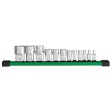
" With the combination of detailed data sets and hyper-realistic digital visualizations, 3D scanning provides a closer inspection to achieve an in-depth analysis of sensitive infrastructure."
-Artec 3D
IRONPROS: What is 3D scanning technology?
Artec 3D: 3D scanning is a technology that brings physical objects or the information about the shape and oftentimes color of an object into the digital world, in three-dimensional form. Far more than a 2D photograph, for example, a highly accurate and precise 3D replica of an object can be inspected, measured, modified, reverse engineered, put through simulations or stress tests, shared, collaborated on, imported in AR/VR environments and far more.
In the professional field of 3D scanning, manufacturers can capture the geometry and appearance of existing products and components. This allows them to analyze and optimize the designs, reducing material usage and improving resource efficiency.
IRONPROS: For 3D scanning structures on jobsites, what Artec 3D hardware and software products are involved in the scanning process?
Artec 3D: There are myriad possibilities for using 3D scanning on jobsites. It’s important to consider the size and features of the object(s) to be captured. For instance, large industrial objects in urban spaces are best captured with a versatile, stationary 3D scanner. These types of scanners require minimal supervision and interaction with the operator yet deliver accurate results in short periods of time. For smaller objects with many intricate details that need to be captured in high resolution, it’s a good idea to use a handheld 3D scanner.
These 3D tools are compatible with Artec’s Studio software, helping provide a guided workflow once the data is scanned and captured. Powered by AI, Artec Studio allows users to easily capture hard-to-reach areas and speed up workflows with automatic processing. Two or more scanners can also be used on the job. For example, scanning an entire site with a stationary 3D scanner and zooming into small parts with a wireless handheld scanner. While on the job, teams can integrate Artec Cloud to keep track of data and project history for modifications as well as access files from anywhere, managing work in a productive manner.
IRONPROS: This technology can be used in maintenance of floodgate doors, for instance the Hugh L. Carey Tunnel and Queens Midtown Tunnel in New York, which recently went through testing. What role does 3D scanning play during inspection?
Artec 3D: For an inspection, especially for a floodgate door, a highly detailed digitization is ideal for uncovering deformations, measuring corrosion and assessing maintenance needs. 3D scanning technology can speed up the workflow for critical testing, going from scan to inspection-ready mesh in hours versus a process that traditionally takes days. In the case of a floodwall, maintenance teams can set up 3D scanners to capture data and digitize a barrier from various angles to ensure they capture any signs of damage – this can make the difference whether a floodgate door will be effective or leak, making detailed data necessary.
IRONPROS: What are the advantages of using Artec 3D scanning over manual inspections?
Artec 3D: Traditional workflows include taking pictures and acquiring physical measurements of objects for manual inspections and can take anywhere from hours to a couple of days to weeks. A 3D scanning workflow speeds up large-scale inspections, completing the aforementioned task in just a few hours. With the combination of detailed data sets and hyper-realistic digital visualizations, 3D scanning provides a closer inspection to achieve an in-depth analysis of sensitive infrastructure. Besides contact-free data capture which makes the job easier, quicker and less disruptive, human error that is bound to creep in while taking manual measurements is drastically reduced.
To give you an example of how 3D scanning can streamline inspections, take Artec partner GoMeasure3D, who are using the Artec 3D scanning system. In an exploratory test of Richmond, Virginia’s historic 25-ft. tall floodwall, GoMeasure3D scaled new heights in civil engineering with the combination of our Ray II and Leo scanners for the job, crediting the speed to uncover deformations and ability to repeat measures as accurately as possible. The modern tooling demonstrates the capabilities of boosting maintenance safety and efficiency.
 Artec 3D
Artec 3D
IRONPROS: What should businesses know about adopting 3D scanning in their operations?
Artec 3D: First, I should say that 3D scanning is increasingly being used to inspect, measure and digitize objects across industrial, medical, automotive, CGI, aerospace and archeology sectors. However, no one scanner solves every challenge. It’s critical for businesses to understand their needs, whether it’s greater accuracy, range, or advanced engineering; it’s essential to know the required tooling, or the combination of solutions to best suit the task. In the business of construction, in this case, it’s vital to consider scale in a field in which engineers need to capture huge sites for project planning purposes. It's also important to understand if the task is a one-time operation, or in the case of creating digital twins, needs to be updated and adapted over time to consistently provide a real time digital representation.
To maximize results with 3D scanning, businesses should understand the following when comparing 3D models:
- Ease of use
- Resolution
- Accuracy
- Speed
- Software
- Price
- Environment
- Range
IRONPROS: Please provide an overview of Artec 3D and its mission.
Artec 3D: Artec 3D is a global leader in handheld and portable 3D scanners. The company was founded in San Diego, California in 2007 and in 2010 the headquarters were set up in Luxembourg where the team operates to this day. In addition to the Luxembourg HQ, Artec 3D has global offices in California (U.S.), Shanghai (China), Bar (Montenegro) and Tokyo (Japan).
We have developed a comprehensive range of 3D scanners used in a wide range of industries. We specialize in manufacturing high-quality, yet easy-to-use hardware as well as smart, user-friendly 3D software – Our professional Artec Studio software allows users to combine data from different Artec 3D scanners, maximizing applications and providing the best integration possibilities, from extra small to entire buildings.
We’re constantly improving and ensuring the scanners can be used by new and experienced users, providing the most seamless workflow.
IRONPROS: What can customers expect from Artec 3D in 2024?
Artec 3D: At Artec 3D we’ve always been at the forefront of developing innovative 3D technology. We’re focused on extending our capabilities in hardware and software to customers across different industries. This year we announced a partnership with ZEISS to expand the range of metrology applications and we have more product announcements to share this fall. Stay tuned!
















